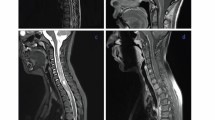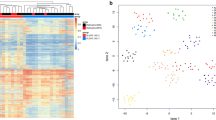Abstract
Intoduction
Diffuse leptomeningeal glioneuronal tumors (DLGNTs) pose a rare and challenging entity within pediatric central nervous system neoplasms. Despite their rarity, DLGNTs exhibit complex clinical presentations and unique molecular characteristics, necessitating a deeper understanding of their diagnostic and therapeutic nuances.
Methods
This review synthesizes contemporary literature on DLGNT, encompassing epidemiology, clinical manifestations, pathological features, treatment strategies, prognostic markers, and future research directions. To compile the existing body of knowledge on DLGNT, a comprehensive search of relevant databases was conducted.
Results
DLGNT primarily affects pediatric populations but can manifest across all age groups. Its diagnosis is confounded by nonspecific clinical presentations and overlap** radiological features with other CNS neoplasms. Magnetic resonance imaging (MRI) serves as a cornerstone for DLGNT diagnosis, revealing characteristic leptomeningeal enhancement and intraparenchymal involvement. Histologically, DLGNT presents with low to moderate cellularity and exhibits molecular alterations in the MAPK/ERK signalling pathway. Optimal management of DLGNT necessitates a multidisciplinary approach encompassing surgical resection, chemotherapy, radiotherapy, and emerging targeted therapies directed against specific genetic alterations. Prognostication remains challenging, with factors such as age at diagnosis, histological subtypes, and genetic alterations influencing disease progression and treatment response. Long-term survival data are limited, underscoring the need for collaborative research efforts.
Conclusion
Advancements in molecular profiling, targeted therapies, and international collaborations hold promise for improving DLGNT outcomes. Harnessing the collective expertise of clinicians, researchers, and patient advocates, can advance the field of DLGNT research and optimize patient care paradigms.


Similar content being viewed by others
Data availability
No datasets were generated or analyzed during the current study.
References
Gardiman MP, Fassan M, Orvieto E et al (2010) Diffuse leptomeningeal glioneuronal tumors: a new entity? Brain Pathol 20(2):361–366
Louis DN, Perry A, Reifenberger G et al (2016) The 2016 World Health Organization Classification of Tumors of the Central Nervous System: a summary. Acta Neuropathol 131(6):803–820
Wisniewski K, Brandel MG, Gonda DD et al (2022) Prognostic factors in diffuse leptomeningeal glioneuronal tumor (DLGNT): a systematic review. Childs Nerv Syst 38(9):1663–1673
Rodriguez FJ, Perry A, Rosenblum MK et al (2012) Disseminated oligodendroglial-like leptomeningeal tumor of childhood: a distinctive clinicopathologic entity. Acta Neuropathol 124(5):627–641
Appay R, Pages M, Colin C et al (2020) Diffuse leptomeningeal glioneuronal tumor: a double misnomer? A report of two cases. Acta Neuropathol Commun 8(1):95
de Los Reyes-Nabhan NK, Scheil-Bertram S, Boppudi S et al (2024) Diffuse leptomeningeal glioneuronal tumor in adults: case report and literature review. Case Rep Oncol 17(1):337–343
Aguilera D, Castellino RC, Janss A et al (2018) Clinical responses of patients with diffuse leptomeningeal glioneuronal tumors to chemotherapy. Childs Nerv Syst 34(2):329–334
Chiang J, Moreira DC, Li X, Furtado LV (2022) Prognostic significance of chromosome arm 1q gain and methylation class in molecularly defined diffuse leptomeningeal glioneuronal tumor. Acta Neuropathol 144(6):1185–1187
Cho HJ, Myung JK, Kim H et al (2015) Primary diffuse leptomeningeal glioneuronal tumors. Brain Tumor Pathol 32(1):49–55
Demir MK, Yapicier O, Yilmaz B, Kilic T (2018) Magnetic resonance imaging findings of mixed neuronal-glial tumors with pathologic correlation: a review. Acta Neurol Belg 118(3):379–386
Deng MY, Sill M, Chiang J et al (2018) Molecularly defined diffuse leptomeningeal glioneuronal tumor (DLGNT) comprises two subgroups with distinct clinical and genetic features. Acta Neuropathol 136(2):239–253
Fiaschi P, Badaloni F, Cagetti B et al (2018) Disseminated oligodendroglial-like leptomeningeal tumor in the adult: case report and review of the literature. World Neurosurg 114:53–57
Gatzert S, Durgam A, Raghuram K, Agarwal A (2023) Primary diffuse leptomeningeal oligodendrogliomatosis with an isolated 1p deletion. Br J Neurosurg 37(4):869–874
Ghoniya R, Raheja A (2019) Imaging in diffuse leptomeningeal glioneuronal tumor. Neurol India 67(2):615–61
Igarashi K, Kawanami K, Yamaki T et al (2020) Diffuse leptomeningeal glioneuronal tumor with subarachnoid hemorrhage: a case report. No Shinkei Geka 48(9):801–808
Jensen MP, Lim E, Dixon L et al (2022) Cerebrospinal fluid cytology findings in a case of diffuse leptomeningeal glioneuronal tumour. Cytopathology 33(6):738–741
Kang JH, Buckley AF, Nagpal S et al (2018) A diffuse leptomeningeal glioneuronal tumor without diffuse leptomeningeal involvement: detailed molecular and clinical characterization. J Neuropathol Exp Neurol 77(9):751–756
Mathews MS, Pare LS, Kuo JV, Kim RC (2009) Primary leptomeningeal oligodendrogliomatosis. J Neurooncol 94(2):275–278
Ozkul A, Meteoglu I, Tataroglu C, Akyol A (2007) Primary diffuse leptomeningeal oligodendrogliomatosis causing sudden death. J Neurooncol 81(1):75–79
Pellerino A, Ruda R, Bertero L et al (2018) Successful use of bevacizumab in an adult primary diffuse leptomeningeal glioneuronal tumor. J Neurosurg Sci 62(2):229–232
Policicchio D, Boccaletti R, Cuccu AS et al (2022) Atypical and aggressive diffuse leptomeningeal glioneuronal tumor in a young adult: a case report and review of the literature. Surg Neurol Int 13:214
Ruppert B, Welsh CT, Hannah J et al (2011) Glioneuronal tumor with neuropil-like islands of the spinal cord with diffuse leptomeningeal neuraxis dissemination. J Neurooncol 104(2):529–533
Tauziede-Espariat A, Siegfried A, Uro-Coste E et al (2022) Disseminated diffuse midline gliomas, H3K27-altered mimicking diffuse leptomeningeal glioneuronal tumors: a diagnostical challenge! Acta Neuropathol Commun 10(1):119
Teoh S, Hofer M, Kerr R et al (2019) Disseminated leptomeningeal tumour mimicking a subarachnoid haemorrhage. Neuroradiol J 32(1):53–56
Xu H, Chen F, Zhu H et al (2020) Diffuse leptomeningeal glioneuronal tumor in a Chinese adult: a novel case report and review of literature. Acta Neurol Belg 120(2):247–256
Yamasaki T, Sakai N, Shinmura K et al (2018) Anaplastic changes of diffuse leptomeningeal glioneuronal tumor with polar spongioblastoma pattern. Brain Tumor Pathol 35(4):209–216
Cambruzzi E, Medeiros MS, Cardoso CE et al (2023) Diffuse leptomeningeal glioneuronal tumor in an 8-year-old girl: case report and review of the literature. Childs Nerv Syst 39(1):301–305
Perilongo G, Garre ML, Giangaspero F (2003) Low-grade gliomas and leptomeningeal dissemination: a poorly understood phenomenon. Childs Nerv Syst 19(4):197–203
Manoharan N, Ajuyah P, Senapati A et al (2021) Diffuse leptomeningeal glioneuronal tumour (DLGNT) in children: the emerging role of genomic analysis. Acta Neuropathol Commun 9(1):147
Chen L, Wang J, Wang X, Wang S, Zhao X, Sun S (2024) Diffuse leptomeningeal glioneuronal tumor with atypical radiological and molecular feature: A case report and literature review. Interdisciplinary Neurosurgery 101972
Deng MY, Sill M, Sturm D et al (2020) Diffuse glioneuronal tumour with oligodendroglioma-like features and nuclear clusters (DGONC) - a molecularly defined glioneuronal CNS tumour class displaying recurrent monosomy 14. Neuropathol Appl Neurobiol 46(5):422–430
Dodgshun AJ, SantaCruz N, Hwang J et al (2016) Disseminated glioneuronal tumors occurring in childhood: treatment outcomes and BRAF alterations including V600E mutation. J Neurooncol 128(2):293–302
Valiakhmetova A, Papusha L, Druy A et al (2020) Pediatric diffuse leptomeningeal glioneuronal tumor: two clinical cases of successful targeted therapy. Pediatr Blood Cancer 67(12):e28478
National Cancer Institute (NCI) (2019) A study of the drugs selumetinib versus carboplatin/vincristine in patients with neurofibromatosis and low-grade glioma (Clinical Trial No. NCT03871257) [Data set]. ClinicalTrials.gov. https://clinicaltrials.gov/ct2/show/NCT03871257
Louis DN, Perry A, Wesseling P et al (2021) The 2021 WHO Classification of Tumors of the Central Nervous System: a summary. Neuro Oncol 23(8):1231–1251
Miller AM, Szalontay L, Bouvier N et al (2022) Next-generation sequencing of cerebrospinal fluid for clinical molecular diagnostics in pediatric, adolescent and young adult brain tumor patients. Neuro Oncol 24(10):1763–1772
Perez-Vega C, Akinduro OO, Cheek BJ, Beier AD (2021) Spinal cord diffuse leptomeningeal glioneuronal tumor presenting without leptomeningeal dissemination. Pediatr Neurosurg 56(6):563–568
Demir MK, Yapicier O, Kilic T et al (2023) Diffuse leptomeningeal glioneuronal tumors: a case series of five patients with parenchymal forms and an analysis of the diagnostic challenges, treatment options and outcomes. Curr Med Imaging 19(12):1415–1426
Lu VM, Di L, Gernsback J et al (2022) Contemporary outcomes of diffuse leptomeningeal glioneuronal tumor in pediatric patients: a case series and literature review. Clin Neurol Neurosurg 218:107265
Chamdine O, Broniscer A, Wu S et al (2016) Metastatic low-grade gliomas in children: 20 years’ experience at St. Jude Children’s Research Hospital. Pediatr Blood Cancer 63(1):62–70
Lassaletta A, Scheinemann K, Zelcer SM et al (2016) Phase II weekly vinblastine for chemotherapy-naive children with progressive low-grade glioma: a Canadian Pediatric Brain Tumor Consortium study. J Clin Oncol 34(29):3537–3543
von Hornstein S, Kortmann RD, Pietsch T et al (2011) Impact of chemotherapy on disseminated low-grade glioma in children and adolescents: report from the HIT-LGG 1996 trial. Pediatr Blood Cancer 56(7):1046–1054
Haizel-Cobbina J, Thakkar R, Richard K et al (2022) Clinical and molecular features of disseminated pediatric low-grade glioma and glioneuronal tumors: a systematic review and survival analysis. Neurooncol Adv 4(1):122
Author information
Authors and Affiliations
Contributions
I. Y. B. and E. B. wrote the main manuscript and all authors reviewed the manuscript.
Corresponding authors
Ethics declarations
Conflict of interest
The authors declare no conflict of interest.
Additional information
Publisher's Note
Springer Nature remains neutral with regard to jurisdictional claims in published maps and institutional affiliations.
Rights and permissions
Springer Nature or its licensor (e.g. a society or other partner) holds exclusive rights to this article under a publishing agreement with the author(s) or other rightsholder(s); author self-archiving of the accepted manuscript version of this article is solely governed by the terms of such publishing agreement and applicable law.
About this article
Cite this article
Ba**, I.Y., Levine, A., Dewan, M.C. et al. Understanding diffuse leptomeningeal glioneuronal tumors. Childs Nerv Syst (2024). https://doi.org/10.1007/s00381-024-06432-6
Received:
Accepted:
Published:
DOI: https://doi.org/10.1007/s00381-024-06432-6




